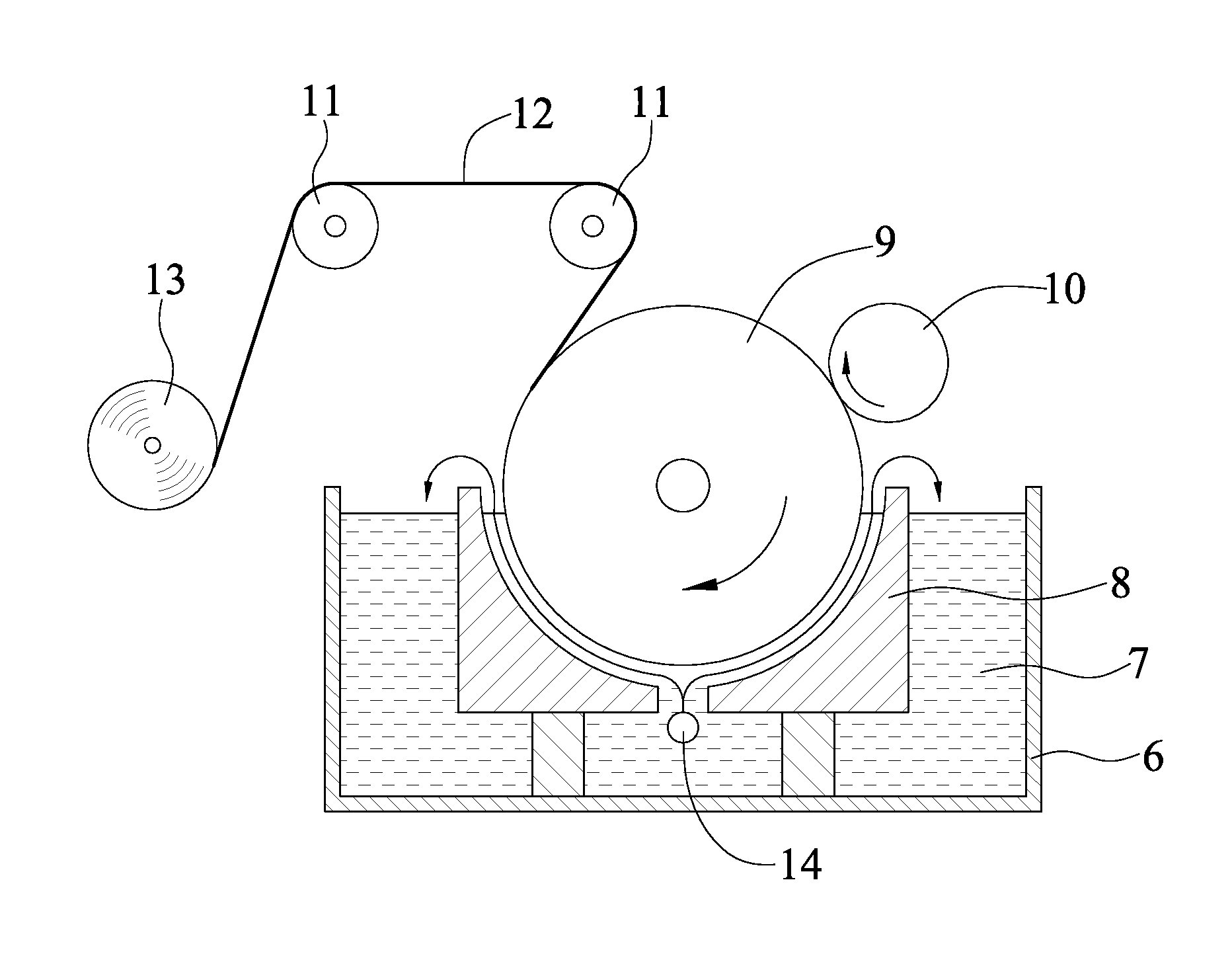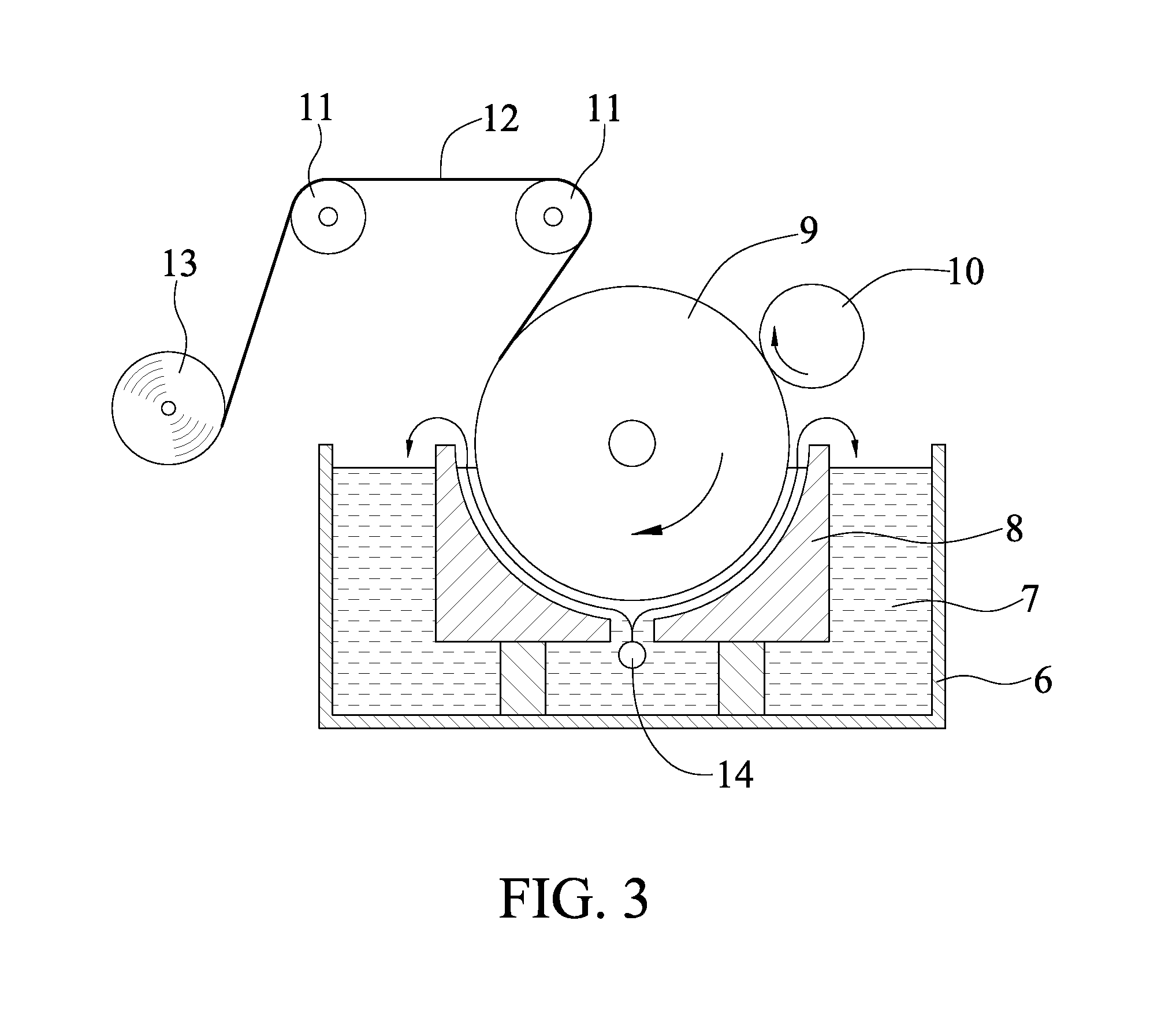Method for producing porous copper foil
a technology of porous copper foil and copper foil, which is applied in the direction of cell components, electrolysis components, instruments, etc., can solve the problems of reducing the capacity poor use efficiency of active substances, and reducing the performance of lithium ion secondary batteries, so as to achieve less roughness differences, improve performance, and reduce the influence of residual oxide films on porous copper foils
- Summary
- Abstract
- Description
- Claims
- Application Information
AI Technical Summary
Benefits of technology
Problems solved by technology
Method used
Image
Examples
example 1
[0039]The chromium-containing compound was transferred by the transfer device shown in FIG. 1, wherein the chromium-containing compound was chromic acid. In Examples 1-1 to 1-5, the concentrations of chromic acid were 1.2, 0.5, 2.0, 3.0, 5.0 (g / L), respectively. In each Example, the chromic acid was introduced into an introducing component 3, which may be a PVC tube, at 100 mL / hr, then dropped on the sponge 22 via the openings 31 of the introducing component 3, and was transferred to the surface of the cathode.
[0040]Operation conditions for electrolysis of the copper foil:
[0041]Composition of electrolysis bath:
[0042]Concentration of copper sulfate: 290 g / L
[0043]Concentration of sulfuric acid: 100 g / L
[0044]Temperature of electrolytic solution: 40° C.
[0045]Current density: 33 A / dm2
example 2
[0046]The device and operation conditions in this embodiment are similar to those of Embodiment 1 except that the chromium-containing compound is sodium dichromate (1.2 g / L).
[0047]The property of the porous copper foils obtained from Example 1 and Example 2 are listed in Table 1. FIG. 4A to FIG. 4C are images showing the pores of the porous copper foil prepared in Example 1-1 by electron microscope.
TABLE 1Chromium-ThicknessPore densityDiameterRz ofRz ofRz differenceExamplecontainingConcentrationof copper foilof copper foilof poreShiny sideMatte sidebetween both sidesNo.compound(g / L)(μm)(1 / mm2)(μm)(μm)(μm)(μm)1-1Chromic1.2102081-301.173.582.41acid1-2Chromic0.5101171-201.102.951.85acid1-3Chromic2.0101761-301.143.802.66acid1-4Chromic3.0101311-301.083.702.62acid1-5Chromic5.010721-301.103.812.71acid2Sodium1.2101801-301.214.573.36dichromate
[0048]As shown in Table 1, in the present invention, the chromium-containing compound is directly provided to form an oxide film on a cathode (without ...
PUM
| Property | Measurement | Unit |
|---|---|---|
| thickness | aaaaa | aaaaa |
| roughness | aaaaa | aaaaa |
| pore density | aaaaa | aaaaa |
Abstract
Description
Claims
Application Information
 Login to View More
Login to View More - R&D
- Intellectual Property
- Life Sciences
- Materials
- Tech Scout
- Unparalleled Data Quality
- Higher Quality Content
- 60% Fewer Hallucinations
Browse by: Latest US Patents, China's latest patents, Technical Efficacy Thesaurus, Application Domain, Technology Topic, Popular Technical Reports.
© 2025 PatSnap. All rights reserved.Legal|Privacy policy|Modern Slavery Act Transparency Statement|Sitemap|About US| Contact US: help@patsnap.com



